Operational Models
The CALP Network’s State of the World’s Cash Report identifies different types of operational model, including consortia and alliances, shared cash delivery mechanisms, single agency cash delivery, and integration of systems.
“The overall structure through which agencies work jointly…to deliver cash and voucher programming…in situation response and analysis, program design and implementation.”
Our working definition of an operational model.
Scaling up CVA offers opportunities to transform how humanitarian aid is delivered. It has implications for the roles of different agencies within various operational models, and the potential for models to link to social protection systems. It will also impact the nature of partnerships with financial service and technology providers, and how different models interact with other forms of assistance, beyond cash.
Current priorities
Since late 2016, the CALP Network has been coordinating a learning agenda to help answer these questions:
- What operational models are available to agencies implementing CVA?
- How do different models improve the efficiency, effectiveness and accountability of CVA in different contexts?
- Which operational models are most appropriate in which contexts?
We will continue to collate and disseminate the evidence base for operational models.
We are also a partner in the Cash Monitoring, Evaluation, Accountability, and Learning Organizational Network (CAMEALEON) consortium, led by Norwegian Refugee Council, which is responsible for independent monitoring and evaluation of WFP’s Multi-Purpose Cash Assistance (MPCA) in Lebanon. This includes research and analysis regarding value for money and accountability in the operational model.
Featured content

Operational Models: Accountability to affected people
Webinar

MEAL in Emerging Operational Models
Webinar

CTP Operational Models Analytical Framework
Guidelines and Tools
The State of the World’s Cash Report launched by the CALP Network in February 2018 highlights trends in the uptake of various operational models for the delivery of cash at scale in humanitarian response. Current decision making on the choice between these various operational models is highly influenced by context, and by the policies and approaches of donor agencies. Decision making on...
Thematic lead
Latest

Reviewing the Linkages between Gender, Market Assessments and Market-based Interventions
Report
From ‘Collected Papers on Gender and Cash Transfer Programmes in Humanitarian Contexts’. Existing gender inequalities mean that disasters and conflicts impact women, men, girls and boys differently. Cash based assistance is one of the most significant developments in humanitarian assistance in recent...

Review of Food for Peace Market-Based Emergency Food Assistance Programs: Zimbabwe Case Study Report
Report
Zimbabwe reflects the recent Southern African drought crisis during a period of a regional El Niño-related drought and a national cash crisis. The United States Agency for International Development (USAID) Office of Food for Peace (FFP) funded a mix of programming between fiscal years 2011 and 2015,...
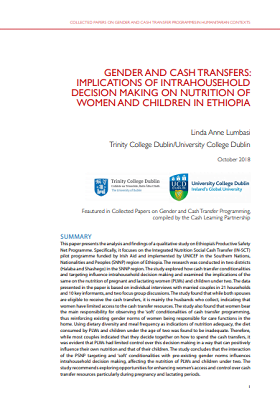
Gender and Cash Transfers: Implications of Intrahousehold Decision Making on Nutrition of Women and Children in Ethiopia
Case Study
From ‘Collected Papers on Gender and Cash Transfer Programmes in Humanitarian Contexts’. Existing gender inequalities mean that disasters and conflicts impact women, men, girls and boys differently. Cash-based assistance is one of the most significant developments in humanitarian assistance in recent...

Tackling the Integration of Gender-Based Violence Prevention and Response and Cash-Based Interventions
Report
From ‘Collected Papers on Gender and Cash Transfer Programmes in Humanitarian Contexts’. Existing gender inequalities mean that disasters and conflicts impact women, men, girls and boys differently. Cash based assistance is one of the most significant developments in humanitarian assistance in recent...
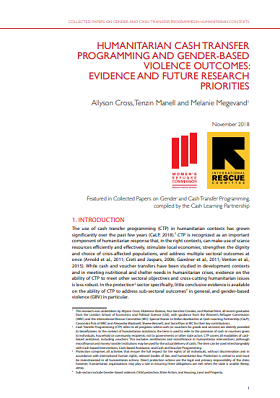
Humanitarian Cash Transfer Programming and Gender-based Violence Outcomes: Evidence and Future Research Priorities
Report
From ‘Collected Papers on Gender and Cash Transfer Programmes in Humanitarian Contexts’. Existing gender inequalities mean that disasters and conflicts impact women, men, girls and boys differently. Cash based assistance is one of the most significant developments in humanitarian assistance in recent...

Cash-Based Programming in South Sudan
Report
This rapid review provides a synthesis of evaluations and learning reviews of cash-based programming in South Sudan. There is evidence that in South Sudan the cash-based programming help poor households address food needs and nutrition; and by injecting funds from vouchers, paid work, or grants into the...

Human(itarian) Capital? Lessons on Better Connecting Humanitarian Assistance and Social Protection
Report
Governments in low- and middle-income countries are increasingly investing in social protection, and also address many of their own people’s “humanitarian” needs themselves. For their international partners, who may have an important role in filling gaps when household needs exceed national capacity...

E-Voucher – Electronic Voucher – Cash Based Programming
Guidelines and Tools
Last Mile Mobile Solutions, LMMS E-Voucher Electronic Solution
The Electronic Voucher provides the ability to:
– Deliver cash programmes to beneficiaries through transfer of electronic vouchers
– Enables full end-to-end digitalized tracking of transactions
– Increases security of the transfers
–...
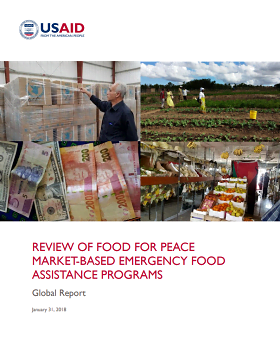
Review of Food for Peace Market-Based Emergency Food Assistance Programs Global Report
Report
Efficient and effective use of humanitarian funds is critical to meet the emergency needs of as many people as possible, especially as emergencies in developing countries have become more numerous, complex, and protracted. The United States Agency for International Development (USAID) Office of Food for...

CTP Operational Models Analytical Framework
Guidelines and Tools
The State of the World’s Cash Report launched by the CALP Network in February 2018 highlights trends in the uptake of various operational models for the delivery of cash at scale in humanitarian response. Current decision making on the choice between these various operational models is highly influenced...
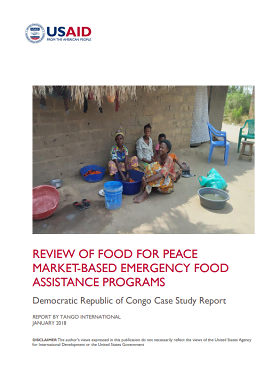
Review of Food for Peace Market-Based Emergency Food Assistance Programs: Democratic Republic of Congo Case Study Report
Report
The Democratic Republic of Congo (DRC) case illustrates the complexity and diversity of contexts within which program design and implementation occurs. It highlights the need for provincial-scale assessments, local market monitoring, and flexibility to pivot to different modalities depending on changing...
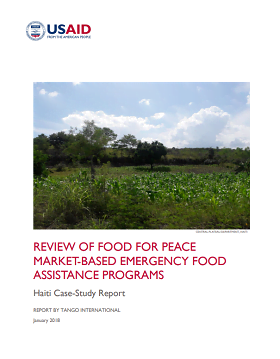
Review of Food for Peace Market-Based Emergency Food Assistance Programs: Haiti Case-Study Report
Report
Haiti is a very low-income country with a degraded ecological setting that faces repeated threats from multiple hazards. It is an excellent example of Food for Peace (FFP) linking emergency and development funding through the Kore Lavi Title II program that serves as a model for the national social...

Review of Food for Peace Market-Based Emergency Food Assistance Programs: Jordan/Turkey Case Study Report
Report
Syria regional crisis: The response to the Syria regional crisis exemplifies the challenges and opportunities involved with delivering food assistance in a widespread, largely urban refugee and internally displaced persons (IDP) crisis affecting middle-income countries. This case study focuses on...

Review of Food for Peace Market-Based Emergency Food Assistance Programs: Kenya Case Study Report
Report
Kenya represents a country focused on building resilience through greater partnerships between USAID-Food for Peace (FFP) programs, other USAID-funded programs and local and national government. DESIGN: FFP MBEP in Kenya is a good example of connecting emergency and development programming and of...

Reflecting on the 2017 Drought Response and Cash Coordination in Kenya
Report
This report brings together thoughts and reflections on the use of cash in the drought response in Kenya in 2017/18 and consider how cash coordination might be strengthened in future. These are from a half day learning event organised by the CALP Network in liaison with the Chair and Co-Chair of the Kenya...

Review of Food for Peace Market-Based Emergency Food Assistance Programs: Nigeria Case Study Report
Case Study
Nigeria is an example of food assistance in a conflict situation in the Sahelian context. The response used information technology to deliver one of the more sophisticated applications of voucher programs. This case is a good example of proactive implementing partner (IP) mechanisms and monitoring systems...
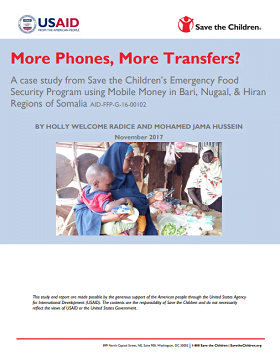
More Phones, More Transfers? A case study from Save the Children’s Emergency Food Security Program using Mobile Money in Bari, Nugaal, & Hiran Regions of Somalia
Report
In 2016-2017, with funding from USAID/FFP, Save the Children implemented a project targeting over 10,000HH the Bari, Nugaal, and Hiran regions of Somalia with monthly cash transfers using Mobile Money a partnership with Golis and Hormuud. The project sought to improve the food security situation in the...

Libya Cash and Markets Working Group (CMWG) Advocacy and Communications Plan
Report
The Libya Cash & Markets Working Group (CMWG) Strategic Framework & 2017 Workplan outlines ‘communication and advocacy’ as a ‘deliverable’ for supporting ‘HC/HCT decision making’.
Throughout March & April 2017, the CMWG Steering Committee used a series of tools as part of a seven-step process...

Discussion Note: Building Evidence and Developing Guidance on Operational Models for CTP
Report
This discussion note summarises the CALP Network’s proposed approach to developing guidance for donors and operational agencies to assess the suitability of different operational models for CTP, by context. The note lays out the current debate relating to different forms of collaboration for CTP, and...

Early Lessons Learnt from Cash Transfer Interventions in Post Matthew Haiti
Report
This technical report has twofold purposes, firstly to describe the main international evidence on cash transfer programing pertinent for the Haitian post Matthew emergency context; and secondly, to document the main lessons that can be learnt from the UNDP post Matthew cash transfer intervention. The...



